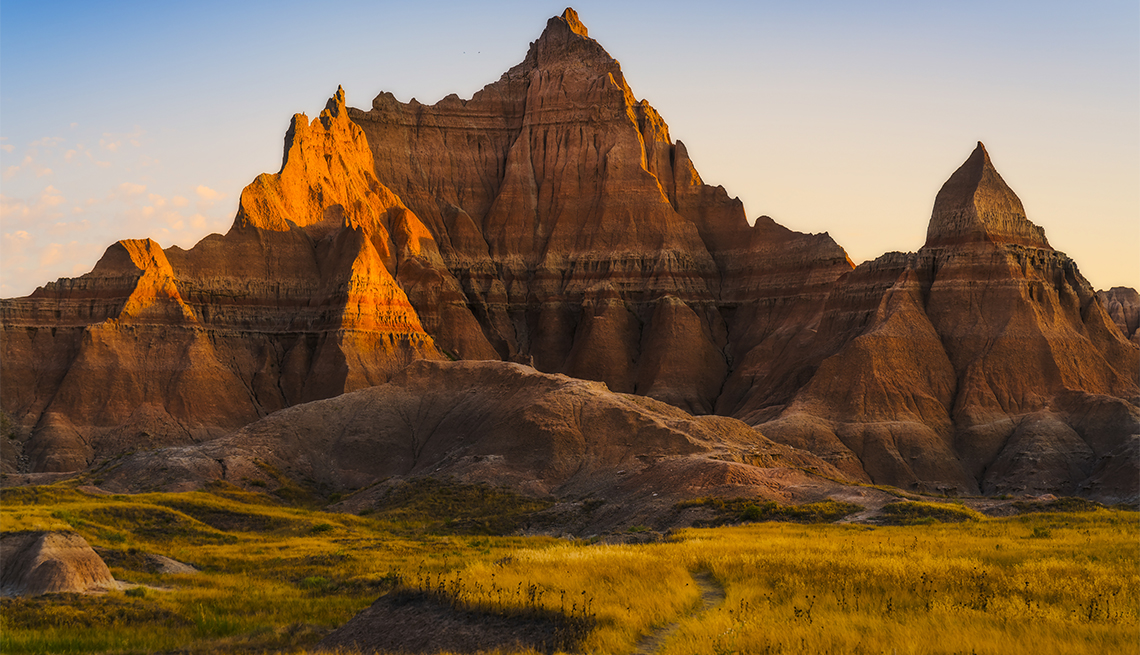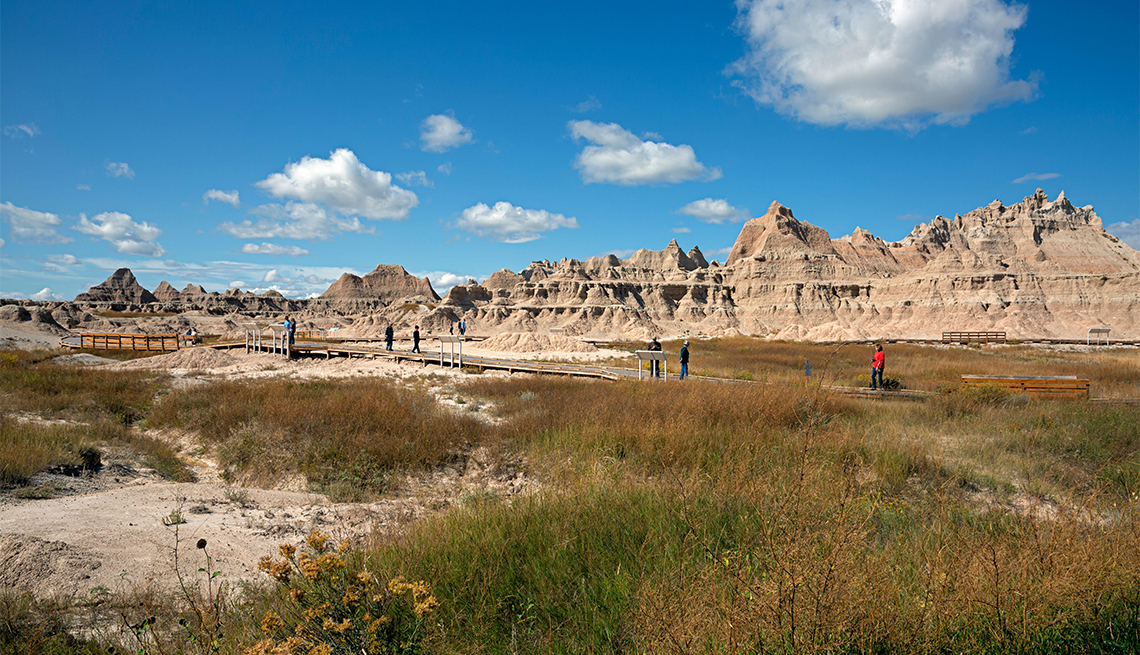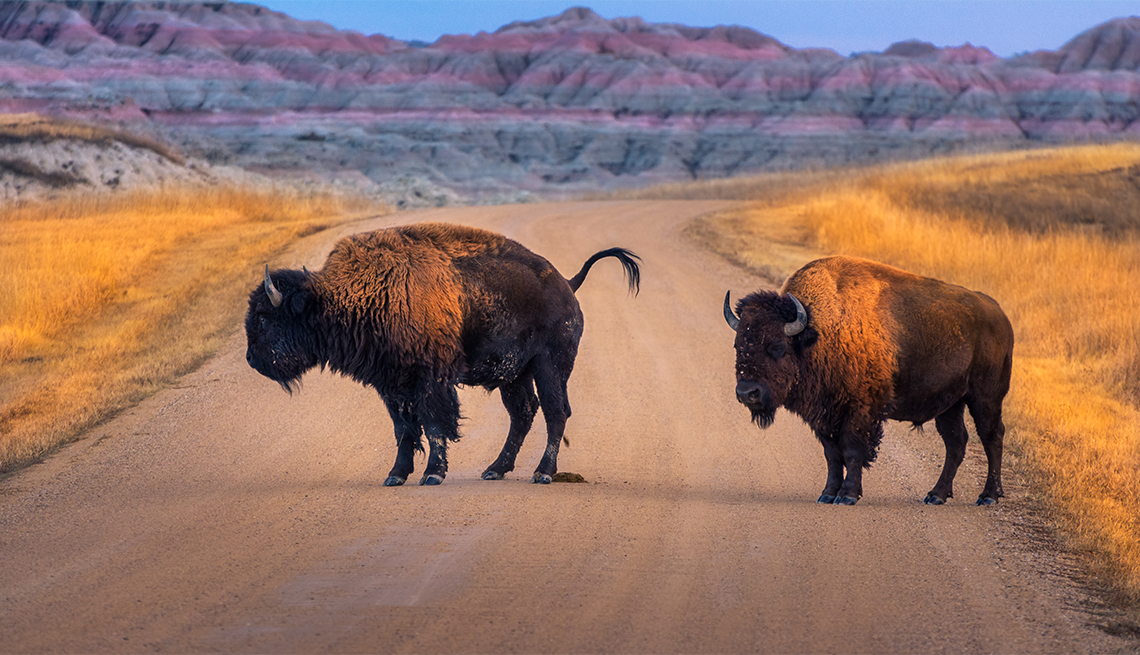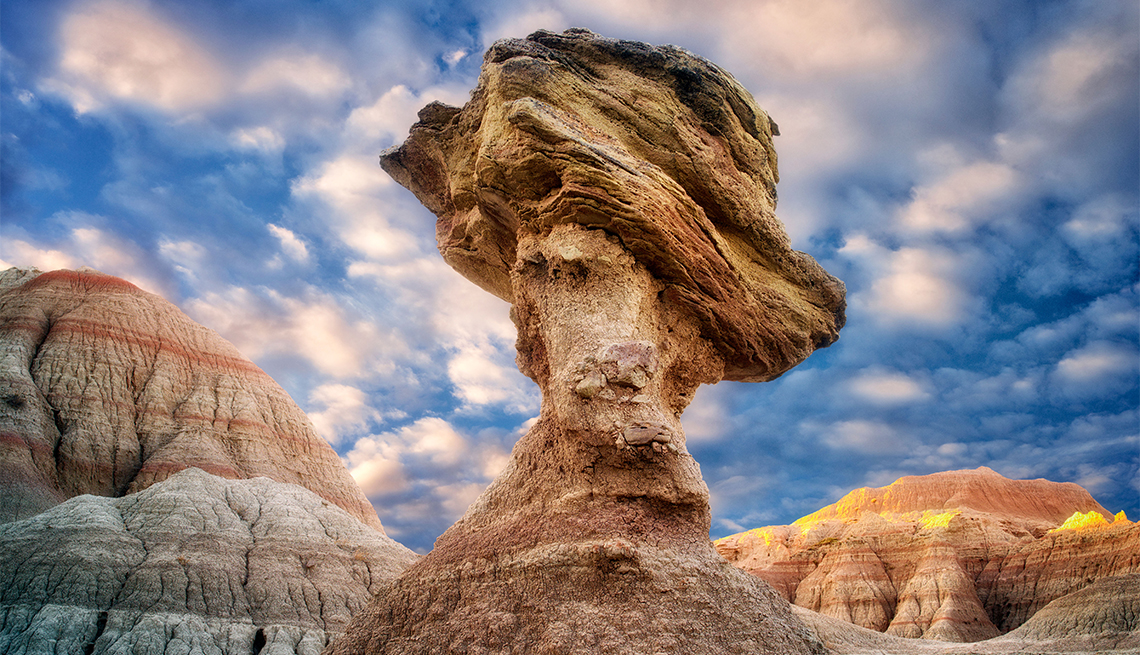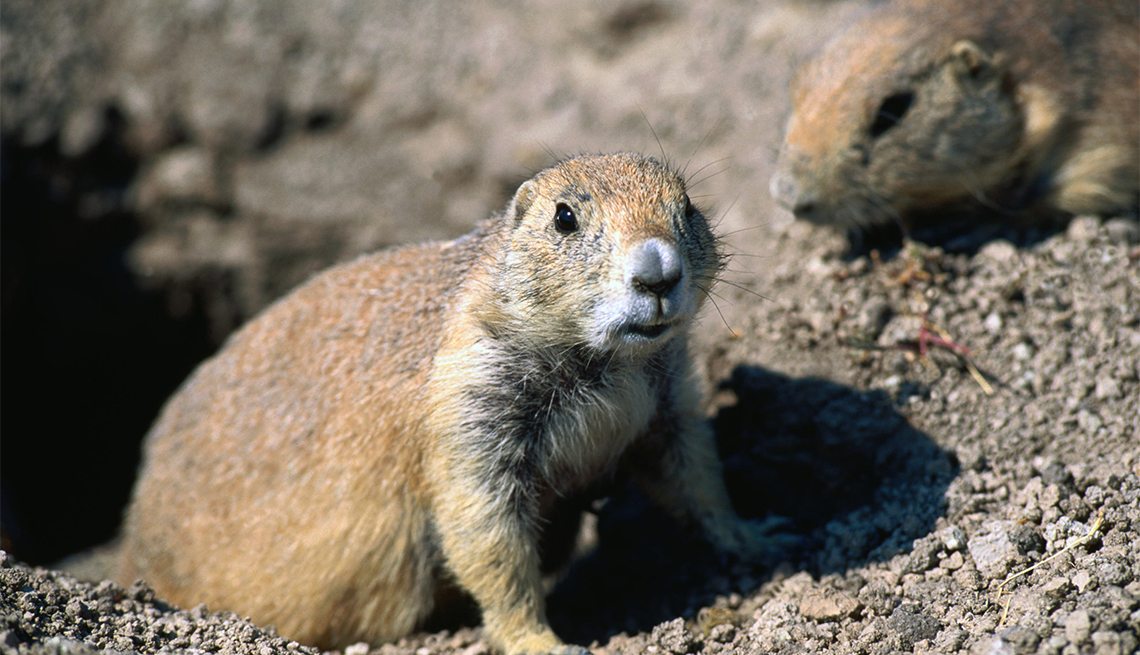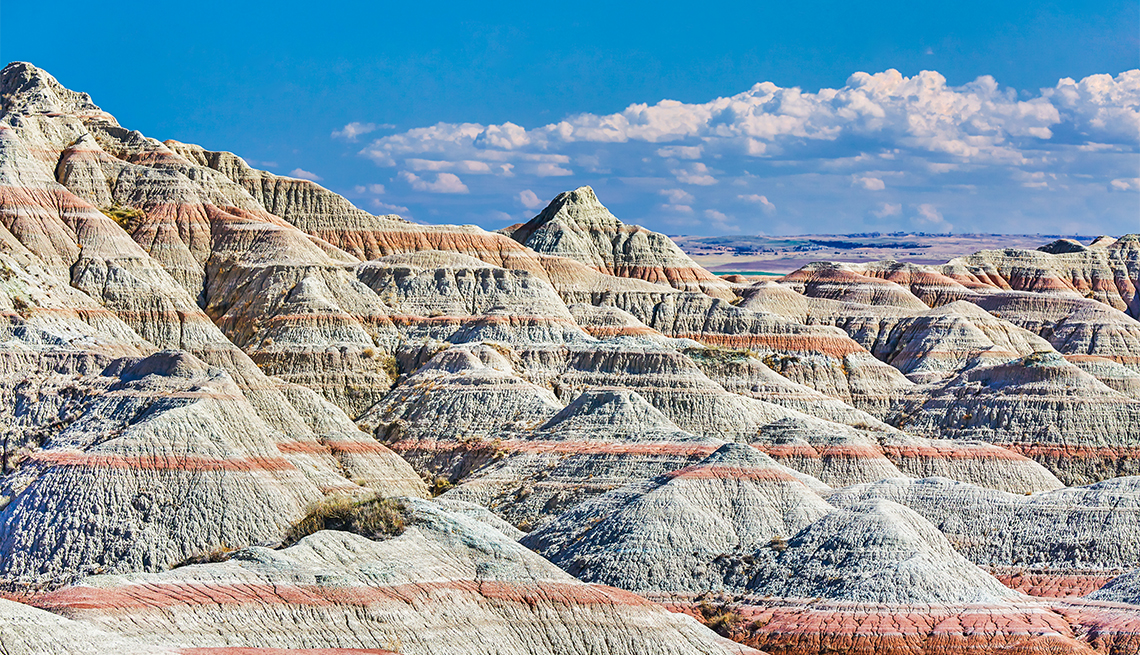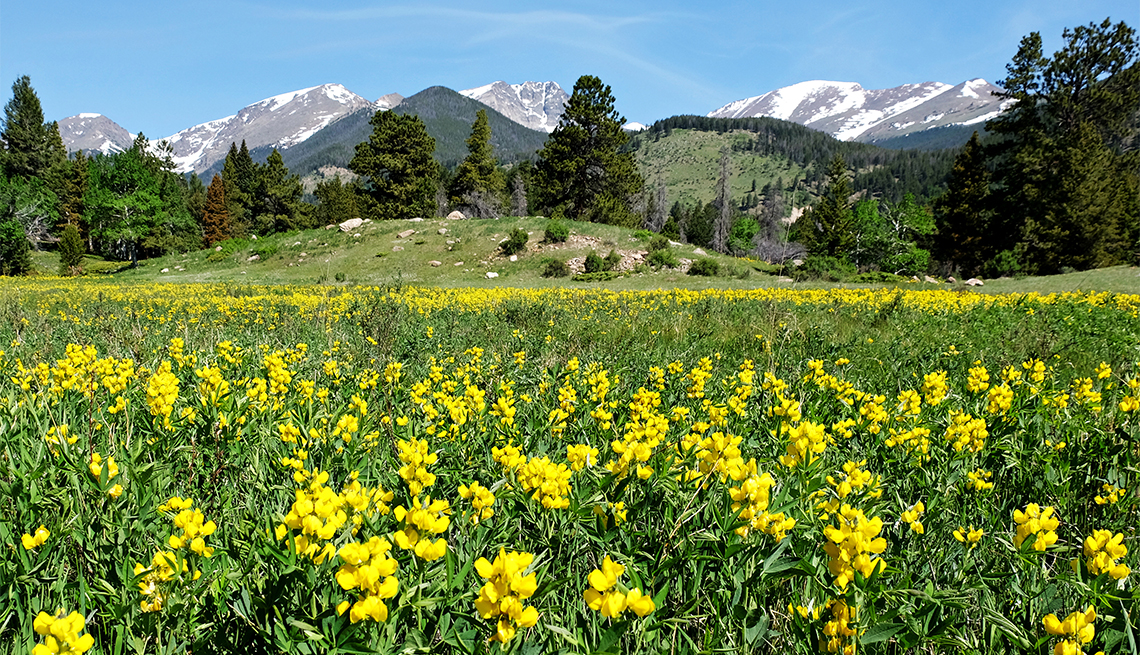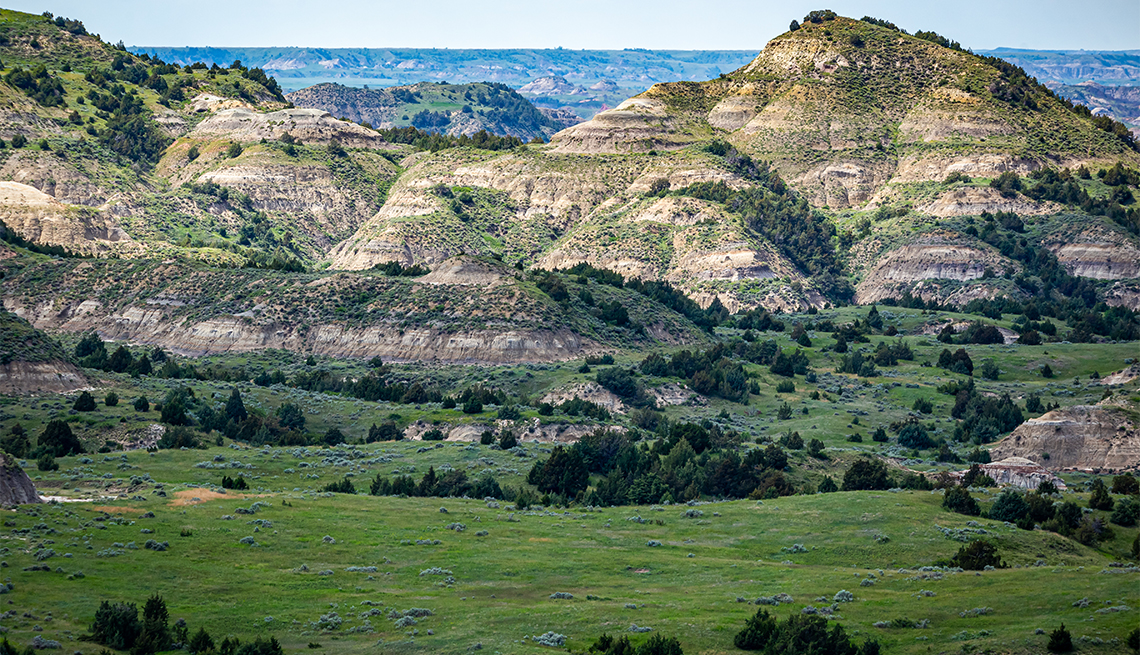AARP's Guide to Badlands National Park
Amber walls and prairie grass make for impressive landscapes in South Datoka
En español | Striped in yellow, amber and purple, the painted walls and serrated peaks of Badlands National Park dip and rise amid the prairie grasslands, making for a stunning surprise in remote western South Dakota. They are both badlands — a geologic term for soft sedimentary rocks that erode easily — and Badlands, a title derived from the Native American Lakota name “mako sica” or “bad lands,” referring to the scarcity of water, difficulty of navigating peaks and valleys and weather extremes that bake the ground in summer and freeze it in winter.
As badlands, the 244,000-acre national park preserves a naturally excavated landscape revealing Earth's history. Rock layers that stacked up over about 75 million years began eroding a half-million years ago, sculpted into channels and canyons by the Cheyenne and White rivers. Sod-covered buttes represent the Ice Age-era prairie, where ancient hunters left behind bison bones and arrowheads up to 12,000 years old.
Paleontologists — often seen working in an active lab at the park's main visitors center — continue to sift through the striated rocks for ancient seashells, ancestors to the modern horse and 50-foot-long marine mammals known as mosasaurs.
To Native Americans, the area was a seasonal hunting ground for buffalo, animals that again inhabit the park, a deceivingly still preserve that teems with life provided you slow down to see it. Bighorn sheep, prairie dogs and pronghorn are just a few of the endemic prairie species that star in the uniquely American safari that visitors can self-guide on foot or by car.
At sunset and sunrise, the vivid hues of mineral deposits in the rocks radiate warmth. Overnight, countless stars pierce the dark night sky. Whether because of time of day, or eons past, change is a motif central to the Badlands, still eroding under nature's forces by about an inch a year.
Where the park is: Western South Dakota
How many acres: 244,000
Highest peak: Sheep Mountain Table, 3,300 feet
Miles and numbers of trails: 17.5 miles among eight trails
Main attraction: Striated rock formations
Cost: Entry $30 per vehicle
Best way to see it: Driving the Badlands Loop Road
When to go to avoid the crowds: Spring
Plan Your Trip to Badlands
The beauty — and the challenge — of BNP is its remote location. The park lies only about 60 miles southeast of Rapid City, South Dakota, home to the closest airport, but about 375 miles north of Denver and 500 west of Minneapolis, the two cities with the closest large airports. The drive from either is fairly rural with farm fields or prairie, which only emphasizes the drama of Badland's colorful eroded hills.
Just shy of a million visitors come to BNP annually, most of those in June, July and August, when the weather is quite hot (highs average above 90 degrees) and prone to thunderstorms. But visitor numbers dip by half in September, when the weather moderates, and even more in cooler May, when you won't have to time your hikes to avoid the heat or the crowds.
Migrating birds are another reason to visit in spring or fall. In spring, you're also more likely to see prairie animals such as bison with their young, and in fall the golden color of turning leaves fill the canyons and ravines. During the cold and biting winter months, wind whips across the largely treeless landscape.
The park is divided into two sections: the main North Unit and the largely roadless and inaccessible Stronghold Unit, located within the Pine Ridge Indian Reservation in the park's southern section. Driving is one of the most popular ways to see the park, and routes such as the Badlands Loop Road (Highway 240) are well-marked. Park entry costs $30 per car ($15 if you enter by foot or by bike).
Think of the BNP as remote and prepare accordingly. You can access free public Wi-Fi in the Ben Reifel Visitor Center, the main visitors center about eight miles into the park from the Northeast Entrance — one of three main entrances, all in the North Unit — but expect spotty cellular service elsewhere. Neighboring Cedar Pass Lodge serves as BNP's only commercial hub, with a restaurant, gift shop and snacks for sale. Restrooms are available here as well as in the park's two visitors centers, campgrounds and picnic area. The lodge, visitors centers and restrooms are fully wheelchair accessible.
Come prepared with ample supplies of water; you'll find few places to refill water bottles. This is especially important if you go hiking; the Park Service recommends two quarts per person for every two hours of hiking. Also bring your own food, sunscreen, hat and sunglasses. Sturdy hiking boots will help with footing on some of the looser trails and also protect you from cactus spines and, possibly, snake bites.
That said, you don't have to be an outdoors expert or hiking ninja to enjoy the park. In addition to scenic drives and turnouts, there are easy short hikes of less than one mile and one fully accessible boardwalk trail as well as wooden boardwalks at most scenic overlooks, which makes them accessible to all visitors.
Where to Stay, Eat in Badlands
The Badlands has no iconic hotel or even many services — but with little commercial fanfare to get in the way it is easy to appreciate its ancient geological, Native American and homesteading past.
For the closest experience to nature, try camping. In addition to backcountry camping for the super experienced, BNP offers two campgrounds. The primitive, first-come-first-served Sage Creek Campground in the park's northwest has 22 sites (free), vault toilets, picnic benches and bison trails. For running water and electricity, opt for the Cedar Pass Campground, adjacent to Cedar Pass Lodge, where you'll find RV and tent camping sites with shaded picnic tables. Two sites are fully wheelchair accessible but most of the terrain around the campsites is accommodating. The lodge also rents 26 pine-paneled cabins with minirefrigerators, microwaves and deck chairs perfect for gazing at the night sky.
Just south of the park, at Circle View Ranch, check into cozy B&B accommodations on a 2,800-acre working cattle ranch. For more adventure, book the property's Hamm Homestead Cabin, built in 1880. It's still without running water and electricity, and you'll have to bring your own bedding, water and camp supplies, but the experience on the edge of the White River is 19th-century authentic.
You'll also find motels and chain hotels — including Econo Lodge and Best Western properties — in the gateway town of Wall on the park's far north side.
Cedar Pass Lodge operates the park's only restaurant, specializing in must-try Sioux Indian Tacos featuring fry bread topped with refried beans, buffalo meat and cheese. For other dining options, you'll need to either bring picnic food or leave the park and head to Wall or the gateway town of Interior in the southeast for casual roadhouses and taverns, including the Badlands Saloon & Grille, best for hamburgers, in Wall.
Things to Do in Badlands
Hike: While breathtaking at a distance, the Badlands are geologically fascinating up close, best explored by hiking. Its eight official hiking trails, all in the North Unit, are not extensive — the longest, the moderate Castle Trail in the park's northeast, is 10 miles round trip — but they introduce the rock formations, canyons, ledges, cliffs and passes interspersed with prairie grasslands. A few trails are strenuous but most are moderate and some, including the quarter-mile Fossil Exhibit Trail, also in the northeast, follow a fully accessible boardwalk.
The park's Open Hike Policy means visitors may go off trail and many do, especially to climb the buttes. But this is often harder than it looks and rangers warn inexperienced hikers against it, as coming down can be more challenging than going up.
Drive: Even if you go hiking, you'll also want to take a drive or two in the park to take in its full scope. The 40-mile Badlands Loop Road, connecting the Northeast Entrance with the Pinnacles Entrance near Wall, winds up and down the contours of the Badlands, threading steep passes with about a dozen opportunities to stop at overlooks and trailheads as well as less formal pullouts for photo ops (most overlooks on the road have wheelchair-accessible boardwalks).
Instead of following the loop road out of the park, continue west via the Sage Creek Rim Road. It's a dirt road but hard-packed and offers a chance to see across the park's largely roadless wilderness area and to look for wildlife.
Watch wildlife: The Badlands appear still, but the more time you spend contemplating the scenery, the more life you'll see in it. Buffalo and pronghorn graze the grasslands, prairie dogs scamper around their towns and bighorn sheep deftly pick their way across rock ledges.
The Pinnacles Overlook off the Badlands Loop Road is a good place to look for bighorn sheep. Off Sage Creek Rim Road, Roberts Prairie Dog Town teems with the burrowing mammals and bison often graze nearby. Cliff swallows come and go from mud nests built on Badlands formations.
Caution: If you encounter a wild animal on a trail, stay at least 100 feet away.
Hunt for fossils: The thousands of years of geologic history revealed in the eroding Badlands have upturned fossils such as the mosasaur, a marine lizard living about 75 million to 69 million years ago when sea covered the area during the Cretaceous Age of the dinosaurs. Prehistoric crocodiles and horses attest to the subtropical climate between 37 million and 34 million years ago, and the drier conditions that followed, between 34 million and 29 million years ago, supported early ancestors to camels, pigs, rabbits and rhinos. The Fossil Exhibit Trail displays fossil replicas and reconstructions of the extinct animals who once roamed here. At the Ben Reifel Visitor Center you can view park paleontologists working on nearby specimens at the Fossil Preparation Lab. Hunting for fossils on your own — to photograph, not take, of course — is best pursued after a rainstorm, when these remains tend to stand out on the wet ground.
Learn history: Human history in the Badlands goes back roughly 12,000 years, beginning with ancient hunter-gatherers; later, the Native American Lakota people followed migrating buffalo to the area for seasonal hunting. In 1887, the Dawes Act stripped more than 90 million acres of tribal land nationally from indigenous people to be given out in “free” 160-acre plots as authorized by the Homestead Act of 1862. Because of the poor soil for farming, however, the government didn't distribute plots until the early 20th century. At the Homestead Overlook on Badlands Loop Road, view a former homesteading region, where prairie grass meets rock walls. Homesteaders would try to bale hay growing atop buttes such as Hay Butte, visible from Sage Creek Rim Road.
Plus, for an in-depth experience: Visit the remote southern Stronghold Unit, located within the Pine Ridge Indian Reservation, established in 1889 and owned by the Oglala Lakota Tribe. During World War II, the U.S. government took more than 340,000 acres from the reservation to establish the Aerial Gunnery Range, which the military used for bombing training. Most of the unit lies within the former bombing range. Here, about a 20-mile drive from the North Unit, visit the seasonal White River Visitors Center, open only in summer, for exhibits on the history and culture of the Lakota people. You'll find few paved roads in Stronghold and the park largely restricts access to Sheep Mountain Table, on the border with the North Unit. The park's highest area at 3,300 feet, it's reached via a backcountry road that requires a high-clearance vehicle or a 14.6-mile round-trip hike.
AARP Membership -Join AARP for just $12 for your first year when you enroll in automatic renewal
Join today and save 25% off the standard annual rate. Get instant access to discounts, programs, services, and the information you need to benefit every area of your life.
Gateway Towns to Badlands
You just might have heard of tiny Wall (population less than 1,000), BNP's chief northern gateway and named for the rock-wall formation that runs across the park, before you get there: Billboards on Interstate 90 touting “free ice water” have been pulling in traffic to Wall Drug since 1936. Originally a drugstore, it's now a tourist attraction — thronged in summer by up to 20,000 visitors a day — with a splash park, Western art gallery-cum-restaurant and a mall selling everything from cowboy boots to mounted Jackalope (a fictional animal). It's a kitschy but must-visit experience complete with homemade donuts and five-cent cups of coffee.
For more to do, consider staying in Rapid City, the state's second-largest city with 75,000 residents, an hour's drive northwest of the park. It's also a gateway to the Black Hills region — home to scenic Custer State Park and three more national park areas — providing a convenient perch between BNP and Mount Rushmore National Memorial.
Downtown Rapid City pays homage to Rushmore with a series of life-size sculptures of 43 American presidents. The town nurtures a lively urban core, best on display at Art Alley, covered in murals by local artists. Visit the Journey Museum to see many of the fossils uncovered in the Badlands.
From excellent Indian/Nepalese food at Everest Cuisine to Italian at Botticelli, Rapid City offers a global dining scene. Don't miss Tally's Silver Spoon, a diner with a gourmet heart specializing in dishes featuring local ingredients from breakfast (think buffalo hanger steak and eggs), to lunch (shaved ham and foie gras sandwiches) and through dinner (grilled quail).
While chain hotels abound, the city's Hotel Alex Johnson, vintage 1928, will appeal to history and style buffs. Built by namesake Alex Carlton Johnson, former vice president of the Chicago and Northwestern Railroad, the 143-room hotel showcases his love of Native American culture in sculpture and iconography in a grand Germanic Tudor building updated with modern amenities such as a rooftop bar and accessible rooms.
En Route to Badlands National Park
Just north of the park, Prairie Homestead preserves the 1909 sod home of the homesteading Brown family, complete with barking prairie dogs in the yard.
If you're driving north from Denver (or even driving around) on Highway 18, stop in Hot Springs, South Dakota, for a soak in its naturally warmed waters. Bathing options range from pools as hot as 102 degrees at Moccasin Springs Natural Mineral Spa to the water-park-like Evans Plunge Mineral Springs. Or wade into the warm waters of Fall River at Brookside and Chautauqua parks. Dry off to check out the Mammoth Site, an active dig site with more than 1,200 fossils of mammoths as well as prehistoric prairie dogs and giant short-faced bear.
About 10 miles north of Hot Springs lies Wind Cave National Park. Below its more than 33,800 acres of prairie and forest lies a vast cave system with rare boxwork formations that resemble honeycombs made of calcite.
From there, it's a scenic half-hour drive north to biodiverse Custer State Park, a 71,000-acre home to pine forests, granite spires and prairie grassland. Its 18-mile Wildlife Loop drive offers a DIY American safari where you're likely to see buffalo (about 1,500 roam in the park), elk, bighorn sheep, mountain goats and prairie dogs.
In the town of Custer, just west of the park, refuel at Black Hills Burger & Bun, where the kitchen staff prepares everything in house, from grinding the meat to baking the buns.
You can't visit the Black Hills region without taking in the 60-foot-high faces of presidents Washington, Jefferson, Theodore Roosevelt and Lincoln carved into granite at Mount Rushmore National Memorial, a little more than 20 miles southwest of Rapid City. Don't miss its Native American counterpart, less than 20 miles west of the memorial, at Crazy Horse Memorial, the still-under-construction mountainside sculpture of the eponymous Oglala Lakota leader.
- |
- Photos
Editor's note: This article was originally published on July 17, 2020. It's been updated to reflect recent COVID-19 developments.

